

© Shipping Wonders of the World 2012-

R.M.S. “Orion”
Many unique features characterize the Orient Line’s largest liner and make her one of the most interesting and important of the large passenger vessels built in recent years
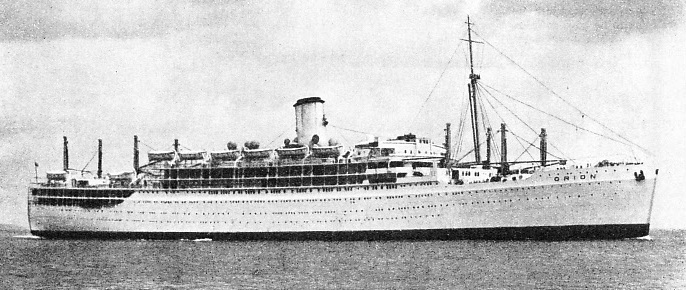
ONE MAST AND ONE FUNNEL are the most outstanding external features in the design of the Orion. A striking departure from common practice was made when it was decided not to erect a dummy funnel or a second mast. With a gross tonnage of 23,371, the Orion was built in 1934 at Barrow-
WHEN, in December 1934, His Royal Highness the Duke of Gloucester pressed a button in Brisbane, Australia, he launched by wireless the Orient liner Orion, built for the Australian service at the Barrow-
She was a large vessel, with a gross tonnage of 23,371. It was not her size, however, that made her the subject of controversy in many circles. There was something about her appearance that suggested she was a ship of the future. She was not streamlined to any great extent, nor were her lines at all exaggerated; but there was something that set her apart from other liners of her size.
It was unusual for large ocean-
Such a departure from common practice, such a refusal to accept precedent for convention’s sake, showed great confidence and courage. The managers of the Orient Line were looking far ahead, and it is possible that the Orion will prove to be the model on which liners of the future will be built.
A similar progressive policy has distinguished the Orient Line from its inception. Its origin was in the firm of James Thomson and Company. In the ’sixties this firm was mainly interested in the trade between Jamaica and Great Britain -
In 1881 steam vessels superseded the sailing ships which had been engaged in the Jamaica trade. History was made when the new vessels brought bananas into Great Britain in good condition. This was done with the aid of a form of cold-
The Australian services at the end of the nineteenth century saw to a marked degree the rapid transition rom sail to steam. Anderson, Anderson and Company saw the trend of affairs in time and their foresight was responsible for the founding of the Orient Line.
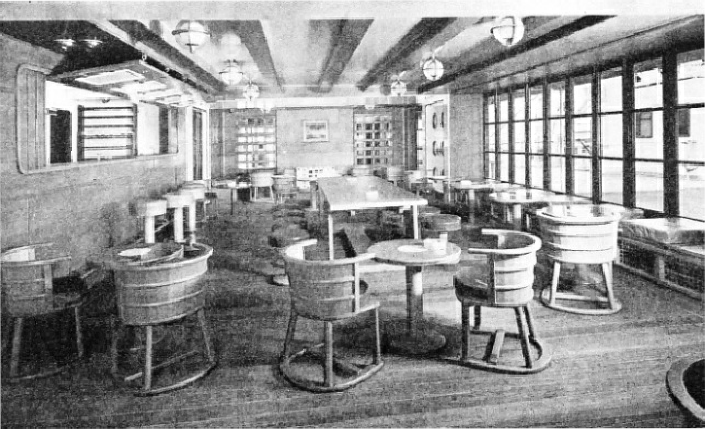
GRENADINE RED AND BUNTING AZURE are the colours, apart from white, which decorate the tavern, adjacent to the first-
The famous wool clippers of Anderson, Thomson and Company, Devitt and Moore, John Willis, George Thompson Junior and Company and other firms were among the undisputed queens of the seas. The first warning of the advent of steam came as early as 1852, when the Peninsular and Orient Company started a service to Australia by the “overland” route. Mails were shipped to Egypt, and thence overland to Suez, for the Suez Canal had not yet been built. A further branch of the P. and O. service ran between Singapore and Australia. This service suffered severe interruptions from the Crimean War, but in 1857 the European and Australian Company started an unsuccessful competitive steamship service.
In 1864 Money Wigram and Sons started a service to Australia with auxiliary steamships which made the single voyage in about seventy days. Unfortunately for them, however, their first auxiliary, the London, was wrecked in the Bay of Biscay in 1866. In 1877 Andersons came to an agreement with the Pacific Steam Navigation Company of Liverpool and chartered four of the company’s steamships, Chimborazo, Garonne, Lusitania and Cuzco. Although the Suez Canal had been opened, these vessels for some time continued to use the Cape route. On one occasion the Lusitania reached Australia in forty days round the Cape.
Complete Air-
These four steamers were acquired in 1878, and the firm amalgamated with F. Green and Company to form the Orient Line. In the following year the Orient Line built its first-
With a speed of about 17 knots, the Orient was one of the fastest vessels afloat. In 1880 a fortnightly service to Australia was inaugurated and the Orient had an active and successful life until she was sold for breaking up in 1909.
In August, 1914, the Orient Line had a fleet of nine ships. Four vessels were lost during the war of 1914-
The majority of the passengers are British and fond of sports on deck. For this reason there is no indoor gymnasium in the Orion, and the mainmast was suppressed to allow for open-
Stripped of all pretences, innocent of ornament for ornament’s sake, a house, a piece of furniture, a saucepan or a ship becomes purely a machine. It may be a machine for living in, a machine for sitting in, a machine for cooking in, or a machine for travelling across the seas; but in its true form a machine of any kind becomes a thing of beauty in itself. A machine stripped of all superfluous matter is not only a thing of beauty, but is also more efficient as a machine. It was not, therefore, the interests of aesthetics, but mainly the interests of efficiency, that led the owners and builders of the Orion to take such trouble over her design.
Everything about a ship should be shipshape. That is not so much a matter of aesthetics as of plain common sense. Yet how many of the great modern liners to-
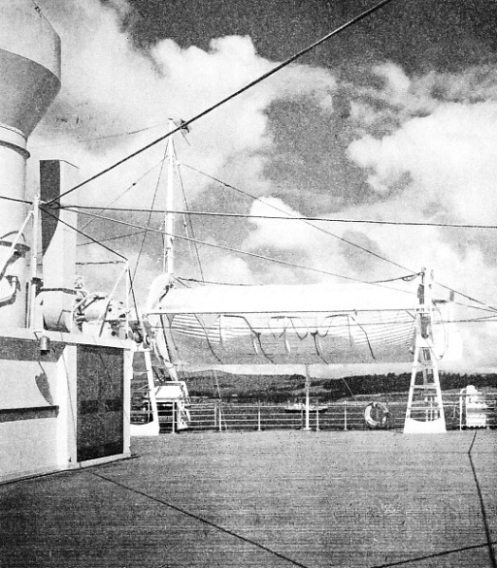
SUITABLY-
For the first time in the history of shipbuilding an architect was called upon to carry out the entire decoration of the ship. At an early stage the architect, Brian O’Rorke, made many suggestions about the arrangement and planning not only of the public rooms but also of the cabins, first-
The architect’s task was a formidable one. The Orion is a large vessel, for she measures 665 feet overall and 630 feet between perpendiculars. She has a moulded breadth of 82 feet and a moulded depth to E Deck of 47 feet 6 inches. Her displacement amounts to 28,400 tons and her draught is 30 feet. Accommodation had to be provided for 486 first-
Galleries lead from the lounge to the library farther aft. The galleries are not mere passages, for along their outer sides are many alcoves which contain writing desks. Armchairs and sofas, with occasional tables, allow passengers to sit at ease without disturbing or being disturbed by passing feet.
Untarnishable Fittings
The library is a fine airy room with sycamore furniture. The after gallery has sliding windows which can be thrown right open so that the gallery becomes part of the dancing space aft. Farthest aft is the cafe, which, far from resembling a period drawing-
Outside the cafe is the veranda, which overlooks the swimming bath on C Deck. The ends of the bath are fitted with special fins which prevent the water from slopping over on to the deck. Two dressing-
There are fourteen two-
All the first-
The dining saloons for either class are on F Deck. The first-
The tourist dining saloon is similar in many ways, but one wall is made entirely of glass and separates the room from the tourist lounge. Stairs lead up to the cafe, which is decorated in fawn and blue. A promenade deck encircles this cafe on E Deck, and right aft are the hospitals in a self-
Tourist-
Every precaution against fire has been taken throughout the ship. The Orion was the first British liner to be fitted with the Grinell sprinkler system, and, in addition, fire-
An installation of this type had previously been ordered for the Orion. Here the system is divided into nineteen sections. The system consists of a series of pipes filled with water under pressure. Valves are fitted in every room and corridor, and when the temperature rises to a certain degree the valves release the water. Simultaneously an alarm is sounded on the bridge and the position of the fire is indicated.
24,000 Horse-
Water is supplied from a tank in the Orion’s engine-
General cargo is carried aft in the lower holds, which have a capacity of 211,240 cubic feet. In Nos. 1, 2 and 3 holds and ’tween decks forward are carried 181,210 cubic feet of frozen and 19,180 cubic feet of chilled cargo. One 20-
On the forecastle deck is the powerful electric windlass with a capstan, driven by electric motors below the deck. Either of these motors is sufficiently powerful to pull up both anchors together. There are two electric warping capstans aft.
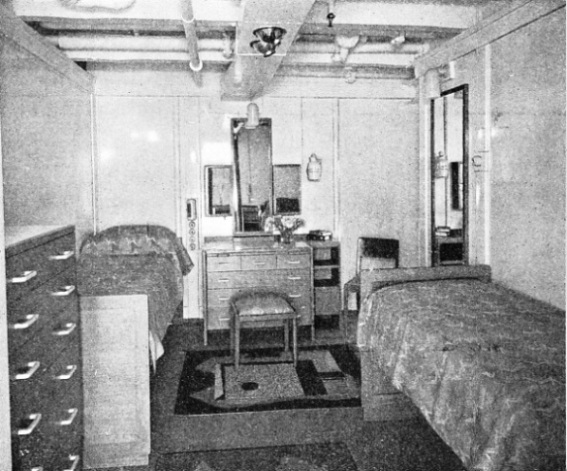
FIRST-
The Orion’s steering gear is of the electric-
Two sets of Parsons turbines drive the twin screws of the Orion through single reduction gearing. The high-
The turbines are designed to run at 1,715 revolutions a minute and develop a total shaft horse-
manganese bronze. Each blade weighs 3½ tons and has a length of 8 feet from tip to flange, giving a diameter of 19 feet to the propeller.
The six Babcock and Wilcox boilers -
Twelve watertight bulkheads arranged transversely up to F Deck divide the Orion into thirteen watertight compartments. In the event of the flooding of any of these compartments, it is necessary for the powTer units and gear which operate the watertight doors to be well above the highest floodable level.
In the Orion the watertight doors are operated on the Scott-
end of the propeller shaft tunnels extends a continuous double bottom. This is divided to form tanks in which fresh water, boiler feed water, ballast and oil fuel are contained. As a further safety precaution a complete double skin has been arranged between the forward cross bunker and the after end of the engine-
No Unnecessary Streamlining
Such is the Orion, the largest Orient liner. Words and figures can convey only an ordinary impression of the appearance of the ship. She has been designed with the greatest skill. Meticulous care has been taken to improve the comfort of passengers on the Australian route, not only in such important matters as air-
To many people the boat deck is the most attractive of all the decks in a ship. Here everything is shipshape. There are no cocktail bars, no luxurious furniture, no enclosures of glass and mirror. Here is the sea tang, the salt breeze; but not always an uninterrupted view of the sea. In the Orion, however, there is an uninterrupted view of the sea. As in many modern ships, the boats are raised on patent davits to well above eye-
This is only a small point that adds to the comfort, or rather the convenience, of the ocean-
Although streamlining has not been carried out in the Orion to any extent, it is only because it is of no practical assistance. The resistance of the air is immaterial compared to that of the water. Yet the wind can be annoying at times. It may spoil the pleasure of leaning on the bulwarks and looking ahead as the ship glides through the waters. So the forward bulwark on A Deck and on the bridge front is curved and provided with a metal chute. This diverts the stream of air over the heads of those on the deck or on the bridge.
This, and similar features, make the Orion important, not only because she is one of the largest ships on the Australian run, but also because she is one of the most sensibly designed ships ever built.
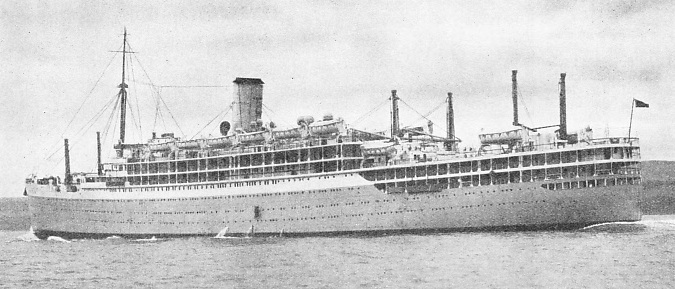
THE CORN-
Click here to view the photogravure supplement to this article.
You can read more on “British Shipping”, “RMMV Stirling Castle” and “World’s Largest Ships” on this website.